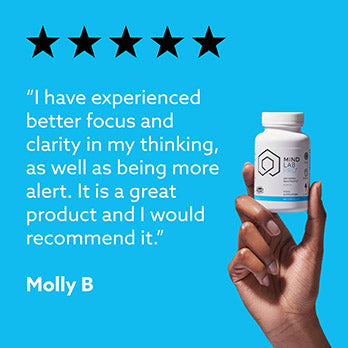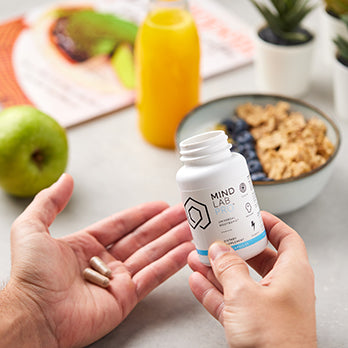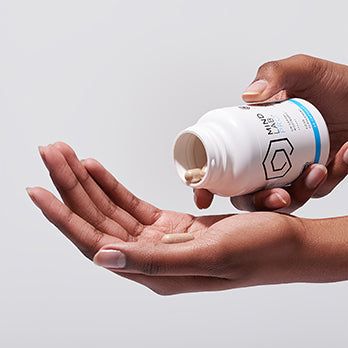Binaural beats are music tracks that can unlock a range of cognitive benefits for focus, creativity and relaxation -- all by influencing brain waves. Some nootropics can also optimize brain waves for superior mental performance.
So what happens when you combine these two brain wave therapies, and take the right nootropics for binaural beats? You might just unlock a higher state of consciousness that elevates your cognitive performance to a whole new level.
Aural Impact on Cognition

The world is a noisy place. Even when we don't consciously hear the noise, it's always there. Traffic, power lines, cellular energy, computer fans, air conditioning -- it all adds up to a lot of background noise.
Staticky electrical and electromagnetic sounds emit a constant drone called noise - white noise, pink noise, brown noise, and grey noise.
This constant noise pollution or interference can overload the brain and cause it to get "stuck" as it tries to interpret all the different signals it's receiving.
Noise pollution can interfere with sleep quality, concentration, learning, and mood.
Brainwave training with binaural beats can help reduce the impact of environmental noise and other everyday stressors.
It gives your brain a break from beta and helps it spend some quality time in gamma, alpha, theta, or even delta states. Nootropics for binaural beats can enhance the effects of brainwave training and extend its benefits for longer periods in beneficial brain wave states.
What are Binaural Beats?
Binaural beats were discovered nearly 200 years ago, but the phenomenon remained largely unknown until the past decade. In 1973, Amercan scientist Gerald Oster used EEG to conduct the first neurological study into the potential cognitive benefits of binaural beats.
The Monroe Institute first promoted binaural beats for cognitive improvement in 1975. For decades it was the only cogent source for binaural beat programs. Today, you can find millions of tracks and programs that use binaural beats. Binaural beats can be matched to any frequency, so you can find one for any cognitive goal.
A binaural beat is an auditory illusion created by the brain to compensate for a missing link that it perceives should be there but is not.
When two separate audio frequencies are presented synchronistically, one in each ear, the brain compensates for the difference by creating a third, “ghost” tone. The third resonance isn’t really there, but the brain “hears” the difference between the two frequencies as if it were.
Binaural beats rely on two separate input locations and only become binaural when listened to through stereo headphones.
If you listen to a binaural track on stereo speakers or an amplifier, it becomes a monophonic beat because both ears are hearing both frequencies at the same time. Mono beats have their own benefits, but they’re different than binaural beats.
Binaural beats seem to be most effective when presented at a level below the range of healthy human hearing (20 Hz). The distance in frequency between two different audible tones determines the frequency of the binaural beat.
- For example, if a 200 Hz tone is played in the left ear at the same time a 210 Hz tone is played in the right ear, the brain will create a tone of 10 Hz. That 10 Hz inaudible tone is the binaural beat.
With those benefits, it makes sense that binaural beats might work hand--in-hand with brain-boosting nootropics.
Brain Wave Entrainment
Binaural beats affect the brain by entrainment, a process of assimilation that occurs throughout nature.
Brainwave entrainment is a deliberate practice to match brain waves to a particular frequency.
Brain Waves 101

The brain cycles through five main electromagnetic states each day. Each brain wave state corresponds to a different level of consciousness. Each level of consciousness has its own traits, and we can maximize those traits by knowing when we are in a certain state and which cognitive functions they heighten.
Like music, brain wave frequencies are measured in Hertz. Hertz measurements are defined by speed and amplitude (loudness).
Gamma
Scientists only recently discovered gamma waves with the advent of highly-sensitive measuring devices that can read a wider range of frequencies. Gamma's properties remain largely mysterious, but it seems to precipitate bursts of laser-like focus, advanced information processing capabilities, and the Mount Everest height of cognitive and physical performance.
Beta
Beta waves originate in the cerebral cortex and hippocampus. The cortex controls higher cognitive functions like language, perception, and attention. The hippocampus is the memory storage center of the brain, and it’s the only region that grows new brain cells throughout your life.<2> At maximum efficiency, beta stimulates learning, memory creation, critical thinking, pattern recognition and more.
However, beta is also the culprit behind most stress. After extended periods in beta, mental clarity begins to wear down, neural networks become clogged, hormonal supplies dwindle, and the sharp signal we start out with sounds more like television static. Nootropics for stress can help reduce the damaging effects of beta confusion.
Alpha
Like a child sometimes needs a time out from overstimulation, the brain needs a break from beta in order to maintain proper behavior. Putting your brain into alpha calms the monkey mind and induces a state of relaxed awareness. Traditional brain herbs can enhance the effects of alpha binaural beats to induce a calm brain state.
Alpha waves begin in the thalamus and move up to the cortex and back again.<3> This full-sweep electromagnetic stimulation promotes improved cognitive function and mental performance while also suppressing the release of anxiety-inducing hormones. Notably, Alpha brain waves are associated with the practice of meditation.
Even a short 5 to 10 minute break spent in alpha recharges your brain – giving you more energy, focus, and creativity.
L-Theanine in Mind Lab Pro® is the best research-backed nootropic for naturally raising Alpha Brain Waves, resulting in a state of wakeful relaxation.
Theta
There are two types of theta brain waves.
Hippocampal theta waves originate in the hippocampus but also activate cortical and subcortical area.
If you ever went on autopilot while walking or driving only to “come to” a few minutes later without any recollection of how you got there, you were operating from hippocampal theta.
Cortical theta waves appear in the occipital/parietal, temporal, and frontal cortices. Cortical theta activates during sensory processing and working memory.<6>
Theta can significantly reduce anxiety and increase imagination. Hypnosis occurs here. Visualizations become more vivid, and creativity is heightened. Young children frequently operate from a theta state, but as we age we enter theta much less often.
Delta
Delta waves can stem from either the thalamus or the cortex. They dominate the right hemisphere during sleep and inhibit neurons throughout the entire brain by coating them with gamma-aminobutyric acid (GABA).
- Delta activity triggers a chain effect that stimulates the release of growth hormone and prolactin from the pituitary.
Delta occurs during stage 3 and 4 sleep. It is the lowest brain wave state where cognitive function is still active, though at rest. This is where the brain regenerates neurons, repairs neural pathways, and patches up frayed DNA. The delta state is crucial to cognitive maintenance and waking peak performance.
Delta Beta Delta
No it's not a college fraternity. It's a detrimental brain wave cycle many people spend most of their life in that can lead to persistent brain drain.
Picture your typical day. A loud, annoying alarm rudely awakens you from delta . You immediately jump into beta, feeling anxious about getting to work on time and making it through the busy day ahead.
You get up, grab a caffeine-laden cup of coffee or tea, maybe laced with a little (or a lot) of sugar. Caffeine and sugar suppress alpha and theta brain waves and amp up beta brain waves. Then you spend most of your day at work, often enduring a stressful commute at either end.
The constant stimulation caused by a heavy work load, household management, maintaining interpersonal relationships, and other responsibilities means most people remain in a beta state from the time they get up in the morning until they fall into bed exhausted, right back into delta.
This delta/beta/delta cycle leaves little room for beneficial alpha and theta brain waves to work their magic. Fortunately, you can fight brain drain and protect your cognitive power, and nootropics for binaural beats can help.
Mind Lab Pro® Nootropics for Binaural Beats
L-Theanine
L-theanine is one of the best natural alpha brain wave boosters. This amino is a natural component of green tea that triggers dopamine release and drops brain waves from beta into alpha. Because of its close association with brain wave regulation, L-Theanine is likely the best overall nootropic to take in conjunction with listening to
L-theanine's nootropic action complements binaural beats' alpha wave generation, promoting a cognitive state of relaxed awareness that improves attention, learning, and memory.<9>
More on Mind Lab Pro® L-Theanine
Citicoline
Citicoline helps synthesize phosphatidylcholine and other phospholipids that protect and regenerate brain cell membranes. Cognizin® citicoline is the best form of this nootropic. It has been shown in human research to optimize electrical impulses in the brain. It may be useful in conjunction with binaural beats to help preserve memory from stress-related brain fog that can occur after extended periods spent in beta.<10>
More on Mind Lab Pro® Cognizin® Citicoline
Bacopa Monnieri
Bacopa stimulates neurotransmitters GABA and serotonin – brain chemicals that support focus, memory and mood. It has been shown to improve cognition, by means of reducing anxiety. And bacopa promotes neuronal communication to improve new learning and memory retention.<11>
More on Mind Lab Pro® Bacopa Monnieri
Rhodiola Rosea
Rhodiola is a stress-busting supplement that improves mental energy and focus through a chain of related factors. It helps balance ATP levels — a coenzyme that helps with the production of cellular energy. It also improves concentration and reduces stress-related mental fatigue by decreasing corticotrophin releasing factor (CRF).
- Lower CRF levels lessens symptoms of stress like brain fog and insomnia, and better sleep reduces excessive amounts of the stress hormone cortisol that can damage brain cells, impairing cognitive function.
More on Mind Lab Pro® Rhodiola Rosea
Stacking Mind Lab Pro® with Binaural Beats
Combining binaural beats and nootropics appears to create a symbiotic effect that even out brain wave frequencies more than either one can alone. They work by targeting the same neural pathways from different angles, providing a double dose of brain boosting power.
Every organic element vibrates at frequencies specific to that element. Radio waves, plants, brain cells, and everything else resonates at healthy frequencies that promote vibrancy.
But when the healthy frequencies of neurons and neurotransmitters get out of whack, cognitive functions like memory, focus, and clarity can degrade and mood destabilizes.
The nootropics in Mind Lab Pro® support healthy cells, while the auditory signals in binaural beats enhance brain wave function.
Together, they can help maintain healthy cognition, balance mood, promote relaxation, encourage creativity and more.
Conclusion
Mind Lab Pro® nootropics for binaural beats work together to tune your brainwaves for peak mental performance.
Whatever cognitive issues you're facing, supplementing binaural beats with nootropics combines two complementary therapies that can improve your quality of life every day. So turn on the tunes and amp up your cognitive flow.
References
- Lane JD, et al. Binaural Auditory Beats Affect Vigilance Performance and Mood. Physiology & Behavior Volume 63, Issue 2, January 1998, Pages 249-252. doi: 10.1016/S0031-9384(97)00436-8
- Boldrini M, et al. Human Hippocampal Neurogenesis Persists throughout Aging. Cell Stem Cell. Volume 22, Issue 4, p589–599.e5, 5 April 2018. doi: 10.1016/j.stem.2018.03.015
- Vijayan S, Kopell, N J. Thalamic model of awake alpha oscillations and implications for stimulus processing. PNAS November 6, 2012. 109 (45) 18553-18558; doi: 10.1073/pnas.1215385109
- Klimesch W. EEG alpha and theta oscillations reflect cognitive and memory performance: a review and analysis. Brain Research Reviews. Volume 29, Issues 2–3, April 1999, Pages 169-195. doi: 10.1016/S0165-0173(98)00056-3
- Buszaki G, Moser E. Memory, navigation and theta rhythm in the hippocampal-entorhinal system. Nature Neuroscience volume 16, pages 130–138 (2013). doi:10.1038/nn.3304
- Sauseng P, et al. Theta coupling in the human electroencephalogram during a working memory task. Neurosci Lett. 2004 Jan 9;354(2):123-6.Raghav S, et al. Randomized controlled trial of standardized Bacopa monniera extract in age-associated memory impairment. Indian J Psychiatry. 2006 Oct-Dec; 48(4): 238–242. doi: 10.4103/0019-5545.31555
- Fink A, Benedk M. EEG alpha power and creative ideation. Neurosci Biobehav Rev. 2014 Jul; 44(100): 111–123. doi: 10.1016/j.neubiorev.2012.12.002Fioravanti M, Buckley AE. Citicoline (Cognizin) in the treatment of cognitive impairment. Clin Interv Aging. 2006 Sep; 1(3): 247–251.
- Del Percio C, et al. “Neural efficiency” of athletes’ brain for upright standing: A high-resolution EEG study. Brain Research Bulletin. Volume 79, Issues 3–4, 29 May 2009, Pages 193-200. doi: 10.1016/j.brainresbull.2009.02.001Zhang H, Jacobs J. Traveling Theta Waves in the Human Hippocampus. J Neurosci. 2015 Sep 9; 35(36): 12477–12487. doi: 10.1523/JNEUROSCI.5102-14.2015
- Larder AL. Neurobiological effects of the green tea constituent theanine and its potential role in the treatment of psychiatric and neurodegenerative disorders. Nutr Neurosci. 2014 Jul;17(4):145-55. doi: 10.1179/1476830513Y.0000000079
- Fioravanti M, Buckley AE. Citicoline (Cognizin) in the treatment of cognitive impairment. Clin Interv Aging. 2006 Sep; 1(3): 247–251.
- Raghav S, et al. Randomized controlled trial of standardized Bacopa monniera extract in age-associated memory impairment. Indian J Psychiatry. 2006 Oct-Dec; 48(4): 238–242. doi: 10.4103/0019-5545.31555



































